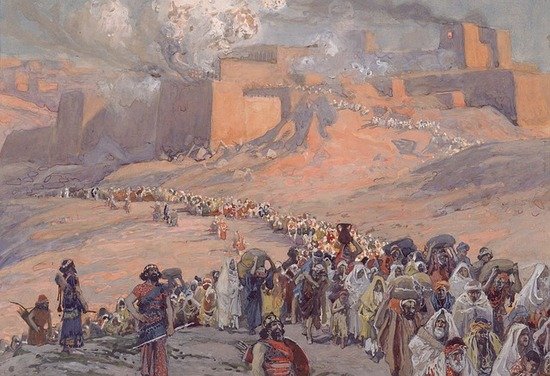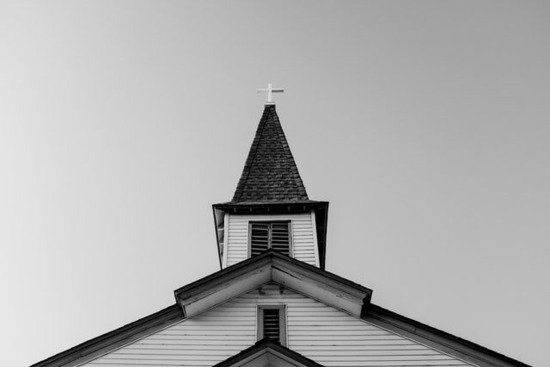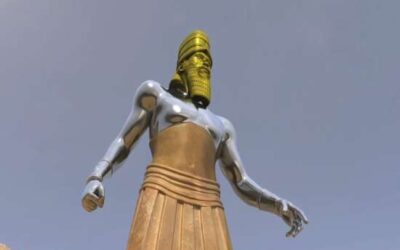Daniel 8:14 introduces us to the longest prophetic timeline in the Bible—the 2300-day prophecy. So what does it mean? When does it start and end, and why’s it so important?
One interesting thing about this prophecy is that by comparing Bible passages in various parts of Scripture, you can “decode” this prophetic timeline to reveal that this prophecy covered the period of 457 B.C. to A.D. 1844.
So let’s dig into the passages involved in this prophecy to determine how these dates were identified, what parts of history were involved, and why.
It’s true that prophecy can seem confusing or complicated, but it can help so much to break it down and go through it step by step.
We’ll cover:
1. What the 2300-day prophecy is
2. When the prophecy begins
3. When it ends
4. The purpose of the Investigative Judgment, and what it accomplishes
5. How the 2300-day prophecy shows what Jesus is doing for us
Let’s start with understanding what exactly is the 2300-day prophecy, and the context in which it was given.
What is the 2300-day prophecy?
The 2300-day prophecy is a prophetic timeline that covers 2300 years out of the history of God’s people, from 457 B.C to A.D 1844. We arrive at this conclusion because of prophetic days actually representing years, based on the day-for-a-year principle from Numbers 14:34 (more on this later).
For now, let’s take a quick look at some backstory to this prophecy.
The context of the 2300-day prophecy
The 2300-day prophecy was given to the prophet Daniel in a vision by the angel Gabriel, as part of a vision recorded in Daniel 8. When it was given, Daniel and some of the Jews of Judah were in captivity in Babylon, but they were soon to be released after a 70-year period.1
The prophecy is found in Daniel 8:14:
“For two thousand three hundred days; then the sanctuary shall be cleansed” (NKJV).
[Other Bible versions, like the ESV, NASB, etc. call them 2300 “mornings and evenings” instead of 2300 days. But these mean the same thing (days), since they each represent half of a day. And even at Creation, a day was referred to as being made of an evening and a morning (Genesis 1:1, 5, 8, 13, 19, 23, 31).]
The prophecy is given in the context of three main prophecies in three different chapters in the book of Daniel—Daniel 2, 7, and 8. They all speak of the rise and fall of great world empires, which would ultimately end with the establishment of God’s kingdom at the second coming of Jesus.
To have a clear grasp on the prophetic interpretation of Daniel 8:14, let’s take a quick dive into its context.
Comparison between Daniel 2, 7, and 8
The context of Daniel 8:14 (2300-day prophecy) is crucial among 3 chapters in the book of Daniel that shows a survey of world history, from antiquity until the end of the world.
Daniel 2
Daniel 2 presents four successive world empires that were followed by God’s eternal kingdom. Here is a summary of what they were and their reign in history:2
- Gold (Daniel 2:37-38) – Babylon (626 B.C. to 539 B.C.)
- Silver (Daniel 2:39) – Medo-Persia (539 B.C. to 331 B.C.)
- Bronze (Daniel 2:39) – Greece (331 B.C. to 146 B.C.)
- Iron (Daniel 2:40-44) – Pagan and Papal Rome, then modern/divided Europe (145 B.C. until the Second Coming)
- Great stone (Daniel 2:44-45) – God’s eternal kingdom after the second coming of Jesus
Many Bible scholars and historians agree on this sequence, including the Biblical Archeology Society.3
Daniel 7
Daniel 7 presents the same kingdoms using different symbols, and provides further detail (Daniel 7:3, 17-18):4
- Lion (Daniel 7:4) – Babylon
- Bear (Daniel 7:5) – Medo-Persia
- Leopard (Daniel 7:6) – Greece
- Dreadful beast (Daniel 7:7, 8,11,19-21,23-25) – Pagan and Papal Rome, then modern Europe that will persecute God’s people
- Kingdom of God that God’s people will possess (Daniel 7:22,27)
But Daniel 7 adds a new element, one not found in Daniel 2.
During the time of the fourth kingdom (Rome), and just before the kingdom of God is set up at the Second Coming, there will be a judgment in heaven. The judgment ushers in the kingdom of God, which will be made up of the followers of God.
The judgment is highlighted three times:
- Daniel 7:9-10, 13-14
- Daniel 7:21-22
- Daniel 7:26-27
The judgment takes place at a time when the fourth kingdom has reached a peak in its persecutions and blasphemies, just before God’s kingdom is established after the second coming of Christ.
Daniel 8
This vision picks up the same sequence of world empires. But it leaves out Babylon and starts with Medo-Persia, probably because the Babylonian empire was about to be conquered and the supremacy would soon shift to the Medo-Persian kingdom (Daniel 5:30; 8:1).5
- Ram – Medo-Persia (Daniel 8:3-4, 20)
- Goat – Greece (Daniel 8:5-8, 21-22)
- Little horn – Rome, a powerful political empire which arises after Greece. It’s considered blasphemous because it discredits God’s sanctuary system and persecutes God’s people.
This kingdom will exist until the end of time, when it will be destroyed “without human means” (Daniel 8:9-12, NKJV; Daniel 8:23-25, NKJV).
And the wording of its destruction is the same as the destruction of the worldly kingdoms and establishment of God’s kingdom in Daniel 2:34-35, 44-45.
Then in Daniel 8:13, Daniel gets to hear an angel asking another angel how long the actions of the little horn will continue. How long will this religious and political power persecute God’s people and desecrate the temple?
And that’s when the 2300-day prophecy is given as an answer.
After 2300 days, the sanctuary will be cleansed (Daniel 8:14). And this cleansing will bring an end to the little horn’s rule and usher in the kingdom of God.
Though the cleansing of the sanctuary seems to be the climax in the prophecy of Daniel 8, the angel Gabriel doesn’t tell Daniel when the 2300 days begin or end. But he specifies that this vision concerns the time of “the end” (Daniel 8:17, NKJV).
And he concludes by assuring Daniel that the prophecy concerns the far future in the end times, and that it’s true:
“And the vision of the evenings and mornings which was told is true; therefore seal up the vision, for it refers to many days in the future” (Daniel 8:26, NKJV).
So, the parallel between the sequence of kingdoms and events in history in Daniel 2, 7, and 8 would be:
| Daniel 2 | Daniel 7 | Daniel 8 |
| Babylon | Babylon | ——————- |
| Medo-Persia | Medo-Persia | Medo-Persia |
| Greece | Greece | Greece |
| Rome | Rome | Rome |
| ——————– | Judgment in heaven | Sanctuary cleansed |
| God’s kingdom | God’s kingdom | ——————- |
By the end of chapter 8, Daniel says he “was astonished by the vision, but none understood it” (Daniel 8:27, NKJV).
The ram, the goat, and the little horn were all explained, but the 2300-day time prophecy wasn’t. And he really wanted to understand it.
So in Daniel 9, angel Gabriel returned to help him understand it.
When does the 2300-day prophecy begin?
The 2300-day prophecy timeline began in 457 B.C. We arrive at this specific year in history by examining the explanation that the angel Gabriel gave Daniel in answer to his desire to understand the details of the prophecy.
This is how it happened.
After the overthrow of the Babylonian empire by the Medo-Persians, Daniel learned that the end of their captivity was near. So he prayed and fasted for his people, pleading with God on behalf of the Jews and the restoration of Jerusalem.
While in this season of prayer, the same angel Gabriel who had interpreted the vision in Daniel 8:16 came to him and said:
“O Daniel, I have now come forth to give you skill to understand … therefore consider the matter, and understand the vision” (Daniel 9:22-23, NKJV).
So far, we know that the last vision Daniel had seen was the one in chapter 8. The one covering the reigns of Medo-Persia, Greece, the little horn, and ending with the cleansing of the sanctuary after the 2300-day timeline.
Daniel still had questions about the 2300 days themselves.
To help him understand, the angel gives him another “time prophecy” (a prophecy that deals with time) that answers Daniel’s prayer about his people returning to their land and the greater hope of the Messiah—and at the same time provides clues to the starting point of the 2300 day prophecy.
This new time prophecy was the 70-week prophecy of Daniel 9:24-27.
The 70-week prophecy
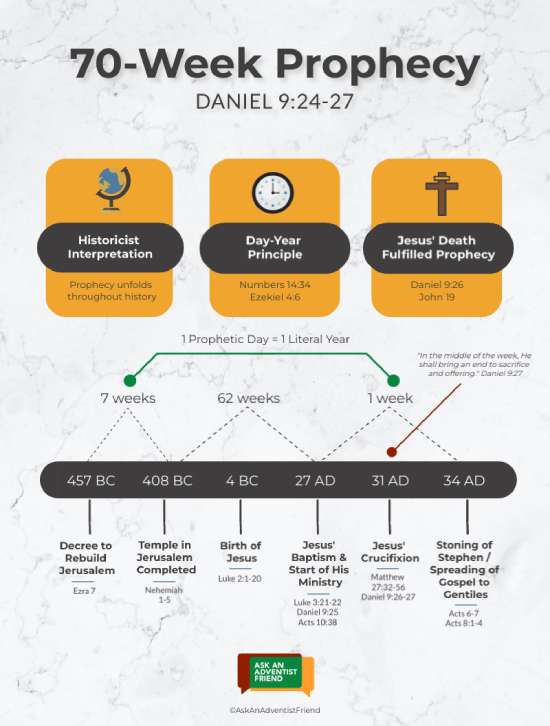 This prophecy has to do with the Jewish nation, from the restoration of Jerusalem after the Babylonian captivity until a little after the coming of the much-awaited Messiah.
This prophecy has to do with the Jewish nation, from the restoration of Jerusalem after the Babylonian captivity until a little after the coming of the much-awaited Messiah.
The angel begins by saying, “Seventy weeks are determined for your people and for your holy city…” (Daniel 9:24, NKJV).
The word “week” here is translated from the Hebrew word shabua, which means seven consecutive days.6 So 70 weeks means 490 days.
And the word “determined” is translated from the word chathak, which means to cut off.7
So the 490 days are cut off…from what?
From the context, we can safely infer that this shorter time period is cut from the longer time period given before—the 2300 days.
The 490 days are cut off from the 2300 days, for God’s people and the holy city (Jerusalem).
This serves both as an answer to Daniel’s prayer for the release of the Jews from captivity, and to give insight into the 2300 days that he wanted to understand.
The angel tells him that during the 490 days, the Jews will carry out several reforms and rebuild Jerusalem in a way that they will function as an independent religious and civic unit. And the end of it will see the baptism and death of the Messiah, and the spread of the gospel to the Gentiles.
But Gabriel doesn’t stop there. He goes ahead and gives the specifics of the prophecy’s starting point. He says:
“Know therefore and understand, that from the going forth of the command to restore and build Jerusalem until Messiah the Prince, there shall be seven weeks and sixty-two weeks; the street shall be built again, and the wall, even in troublesome times” (Daniel 9: 25, NKJV).
So the time period begins with the command or decree to restore and rebuild Jerusalem. And there are 69 weeks (483 days) between this decree to the time Jesus the Messiah begins His ministry in His young adulthood.
So when was this decree that marks the beginning of the 490 days given?
A look at historical records in the book of Ezra show that three decrees were given by various Medo-Persian kings:8
- The first by king Cyrus in 537 B.C. (Ezra 1:1–4)
- The second by king Darius I around 520 B.C. (Ezra 6:1–12)
- The third by king Artaxerxes in the autumn of 457 B.C. (Ezra 7:1–26)
Of these three decrees, it’s only the third that made provisions for the Jews to operate as an autonomous state within the Medo-Persian empire, and made it possible for a complete restoration of the city.
So the decree that marks the beginning of both the 2300-day prophecy and the 70-week prophecy is the one issued in 457 B.C.
But taken as literal time, 70 weeks is just one year and about four months. And that is not enough to get from the command to restore and rebuild Jerusalem, in the fifth century B.C., to the Messiah, Jesus, who came in the first century A.D.
This brings us to a principle called the day-for-a-year principle, which is applied when interpreting prophetic timelines.
Let’s look at it briefly.
Day-for-a-year principle
The day-year principle explains how a day in biblical prophecy symbolizes a year in literal time. It’s also referred to as the “year principle.”
Its basis in Scripture is found in passages like:
- Numbers 14:34—God told the Israelites that they’ll wander in the wilderness for 40 years, with every year representing each day that the spies spent in Canaan (Numbers 13:25).
- Ezekiel 4:5-6—God commanded prophet Ezekiel to lie down on his left side for 390 days, and then on his right side for 40 days, as a symbol of the number of years that God would punish Israel (390 years) and Judah (40 years).
The day-year principle has a solid biblical and historical foundation in the theological scene. It was used by both Jewish and Christian interpreters throughout church history, and many Protestant reformers who uphold the historicist school of thought in prophetic interpretation.9
Examples include Jewish writings like The Book of Jubilees and Seder Olam, Bible historians Tichonius and Benjamin Ben Moses Nahawendi, and the reformers Philipp Melanchthon and Martin Luther.10
Using this principle for the 70 weeks prophecy, we get 490 years. And if counted from 457 B.C., we get to A.D. 26 in 483 years.
But since in counting years there’s no “0” year when shifting from B.C. to A.D. (as you would on a number line), we add an extra year to make it A.D. 27. And this is the year Jesus is historically believed to have been baptized, marking the beginning of His public ministry on earth before His death on the cross.
Then if we add the remaining 7 years (to make it 490 years), we get to A.D. 34. And this fulfills the prophecy.
To learn more on the specifics of the 70 weeks and its fulfillment in history,
Now that we have ascertained the fall of 457 B.C. as the starting point of the 2300-day prophecy, let’s look at when it ended and the circumstances around that time.
When does the 2300-day prophecy end?
 The 2300-day prophecy ends in the fall of A.D. 1844. Here’s how we arrive at this date:
The 2300-day prophecy ends in the fall of A.D. 1844. Here’s how we arrive at this date:
Using the year-day principle, we have 2300 years for the 2300 days. Counted from 457 B.C., we get to 1843.
But again, considering the “0 year” when shifting from B.C. to A.D., we have to add an extra year to the count to make it 1844.
Fall 457 B.C.______________2B.C., 1B.C., 1A.D, 2A.D.___________Fall 1844 A.D.
And because the decree by Artaxerxes was given in the fall of 457 B.C., the end of the 2300 years also falls in the fall of 1844.
So what happened in the fall of 1844?
From the text in Daniel 8:14, we read that the sanctuary would be restored, or as the King James and New King James versions put it, “cleansed,” at the end of the 2300 years.
This word “cleansed” comes from the Hebrew root word nisdaq, which means to be put right. Or to be made clean, restored, and vindicated.11 Many other modern translations reflect that.
And as we saw in the sequence of events in history that involved the rise and fall of nations depicted in Daniel 2, 7, and 8, the cleansing of the sanctuary in Daniel 8 parallels the judgment in heaven in Daniel 7.
That means that just like the various empires were depicted by different symbols to show their various characteristics in the different chapters, the cleansing of the sanctuary and the judgment are one and the same thing. And it happens just before the Second Coming, during the time of the fourth kingdom.
So what does the cleansing of the sanctuary mean?
Looking through the Bible, there is only one occasion when the sanctuary (temple) was cleansed—on the Day of Atonement.
What happened on the Day of Atonement?

Photo by Edgar Chaparro on Unsplash
The Day of Atonement was a day when the sins of the Israelites which were transferred to the sanctuary all year through animal sacrifices were ceremonially cleansed.
It happened on the tenth day of the seventh month, at the end of the Hebrew calendar (Leviticus 16:29, 34).
It was considered a Sabbath, where no one would do any work, and everyone in Israel was to confess their sins (Leviticus 23:32).
The rituals of the day are described in Leviticus 16. It was a day when the sins of the Israelites that had been transferred to the sanctuary through sacrifices throughout the year were finally cleansed from the sanctuary.
This was the only day in a year when anyone (the high priest) entered the Most Holy Place in the sanctuary (Hebrews 9:7).
The high priest would first atone for his own sins and the sins of his household in the Most Holy place by offering a bull as a sin offering (Leviticus 16:11-14).
Then he would atone for all of Israel by bringing two goats before God in the sanctuary. He would then cast lots and pick one to be sacrificed for the sins of Israel, and the other to serve as the “scapegoat.” The blood of the live goat would be sprinkled in the Most Holy place, at the mercy seat, and on the altar for the sins of Israel (Leviticus 16:7, 8, 15-18).
All this to “cleanse [the sanctuary], and consecrate it from the uncleanness of the children of Israel” (Leviticus 16:19, NKJV).
(All this blood that was to “cleanse” things pointed forward to when Jesus would die for the human race on the cross. He bled and died for us to cleanse us from the forever stain of sin, and the animal sacrifices helped the Israelites understand this so they knew what was to happen later with Jesus.)
After these, he’d bring the live goat, lay his hand on its head, and transfer all the sins of the Israelites that had been transferred to the sanctuary through the blood of sacrifice to it.
He’d “lay both his hands on the head of the live goat, confess over it all the iniquities of the children of Israel, and all their transgressions, concerning all their sins, putting them on the head of the goat, and…send it away into the wilderness by the hand of a suitable man. The goat shall bear on itself all their iniquities to an uninhabited land; and he shall release the goat in the wilderness” (Leviticus 16:20-22, NKJV).
While the high priest was doing all this in the sanctuary, everyone in Israel was required to stand outside and search their hearts, confessing their sins (Leviticus 16:29-31).
If anyone focused on other things and failed to confess their sins so that they were not transferred to the temple through the sacrifice, and eventually removed from the sanctuary through the scapegoat, that person would die (Leviticus 23:29). This showed Israel just how serious sin is.
Death would be God’s judgment on their sin, which would still be found on them while the rest of Israel had been cleansed.
In this sense, the Day of Atonement was a day of judgment. A day when each individual would be examined. And if they had confessed their sins, they would be blessed. But if it was found that they were holding onto sin and refusing to confess it, they would be condemned to die.
So what does this judgment on the Day of Atonement, connected to the earthly sanctuary, have to do with the judgment in heaven of Daniel 7?
The judgment in heaven
The Day of Atonement and its services were all done in the earthly Old Testament sanctuary.
But in the book of Exodus, we learn that God instructed Moses to model this earthly sanctuary after another one—meaning it was a replica of another sanctuary (Exodus 25:8-9).
Then Paul tells us that the earthly sanctuary was a “copy and shadow of the heavenly things.” A copy of the heavenly temple made by God Himself and not by man (Hebrews 8:2, NKJV; Hebrews 8:5, NKJV).
So the earthly sanctuary and everything about it was to be a copy or shadow of heavenly things. Meaning, they were to give us a glimpse of what is happening in the heavenly temple (Hebrews 8:5).
A lot of these parallels are found in the New Testament. And many of them reveal that most of the services, feasts, and articles of the earthly sanctuary pointed to the life and ministry of Jesus, and were fulfilled by various milestones in His plan to save us from sin.
Examples of how various aspects of the earthly sanctuary parallel various aspects of the plan of salvation and Jesus’ ministry in the heavenly sanctuary include:
- The animal sacrifices offered for the forgiveness of sin pointed to Jesus’ ultimate sacrifice for us by His death on the cross.
Jesus is “the Lamb of God, who takes away the sin of the world!” (1 John 1:7; John 1:29, ESV).
- The ministry of priests symbolized Jesus’ priesthood in the heavenly sanctuary.
First, immediately after His resurrection and ascension into heaven, Peter said that Jesus was at the right hand of God (Acts 2: 33).
Also when Stephen was being stoned, we read that “being full of the Holy Spirit, [he] gazed into heaven and saw the glory of God, and Jesus standing at the right hand of God” (Acts 7: 56-57, NKJV).
Then Paul references Jesus as our “High Priest, who is seated at the right hand of the throne of the Majesty in the heavens, a Minister of the sanctuary and of the true tabernacle which the Lord erected, and not man (Hebrews 8:1-2).
- Hebrews 9:2,6 specifies that the priests ministered daily in the first part or the Holy Place.
The apostles had a lot to say of Jesus’ continued ministry for us in the heavenly sanctuary. For example:
-
- He intercedes for us to the Father (Hebrews 7:25; Romans 8:1).
- He is our advocate before God the father when we sin (1 John 2:1).
- He is our great high priest who sympathizes with us and gives us grace, mercy, and help in our times of need (Hebrews 4:14-16).
- Hebrews 9:3,7 tells us that once a year, the high priest entered the second part, or the Most Holy place.
This only happened on the Day of Atonement.
And Hebrews 9:23-26 tells us that just like the priests in the earthly sanctuary, Jesus enters the Most Holy Place once and for all to purify or cleanse heavenly things (sanctuary) by His own blood and sacrifice. He has appeared before God in heaven for us to put away sin.
Hebrews 9:26 categorically states that Jesus has appeared “once at the end of the ages…to put away sin” (NKJV).
From this, we start to get links to the passages in the book of Daniel.
Prophetic application of Old Testament sanctuary services
First, the judgment and the cleansing of the sanctuary happen during the fourth kingdom, just before the second coming of Jesus, in the End Times. And the angel also told Daniel that the prophecy about the cleansing of the sanctuary concerned the “time of the end” (Daniel 8:17, CSB).
Then Hebrews 9:27 introduces the judgment that all people must face at some point, even after death, and that Jesus died in order to bear our sins.
And Hebrews 9:28 says that for “those who eagerly wait for Him, He will appear a second time, apart from sin, for salvation” (NKJV).
Here, we are introduced to Jesus’ second coming.
After coming to earth the first time to bear our sins, and after the work of judgment in the heavenly sanctuary, He comes to save us (but this time, His work of bearing our sins is over, and those who have accepted His sacrifice are saved).
These texts tie His work of cleansing the sanctuary in heaven (which is represented by the Day of Atonement in the earthly sanctuary), with the work of judgment that happens before His second coming in the end times.
How does the judgment in heaven tie to the end of the 2300 years, in 1844?
As we’ve discovered, the autumn of 1844 marked the beginning of this work in the heavenly sanctuary.
It’s when Jesus moved from the first part of the sanctuary (Holy Place), to the second part (Most Holy Place) of the heavenly sanctuary.
So the end of the 2300-day prophecy of Daniel 8:13-14 points to the date when Christ’s ministry in the Most Holy Place in heaven would start.
And this is the event that the Day of Atonement described in Leviticus 16 and in Leviticus 23:26–32 pointed to.
This movement from the Holy place to the Most Holy Place is what is described in Daniel 7: 9-10, 13-14.
Daniel says that he saw “thrones set in place, and the Ancient of Days took His seat.” These thrones had wheels, so they were movable (Daniel 7:9, CSB).
Remember in Hebrews 8:1-2, we read that Jesus is at the right hand of the throne of God. But this time, the throne of the Ancient of Days (God the Father) is set up and Daniel only sees the Father.
God the Father moves from the Holy Place while Jesus stays.
And the whole setup was that of a courtroom. The Bible says the “court sat in judgment,” and books were opened (Daniel 7:10, ESV).
Then at some point, “One like the Son of Man” comes with the clouds of heaven to the Ancient of Days (Daniel 7:13, NKJV).
And we can conclude that Jesus is the Son of Man, from the many times He described Himself as the Son of Man.12
Remember again that this is a courtroom scenario, and the earlier description of Jesus as our advocate in 1 John 2:1 fits perfectly in this context.
The result of the court hearing is that Jesus is “given dominion and glory and a kingdom, that all peoples, nations, and languages should serve Him” (Daniel 7:14, NKJV).
Daniel goes ahead to describe His dominion as an everlasting dominion, which can neither end nor be destroyed.
So it shows the two last phases in the sequence of kingdoms in the book of Daniel—a judgment, followed by God’s everlasting kingdom.
And from the earthly sanctuary model, we see this judgment happened in the Most Holy Place on the Day of Atonement. And so the judgment in the heavenly sanctuary in the end times is the fulfillment of the Day of Atonement.
And since the cleansing of the sanctuary at the end of the 2300 years in Daniel 8 parallels the judgment in Daniel 7, we can safely conclude that the movement of God (and then Jesus) to the Most Holy Place, and the judgment that follows, happened in fall of 1844.
But you may wonder, did Christians or people realize that this was happening in heaven in 1844?
Yes, a lot of people.
Here is their story, and how they understood the fulfillment of this prophecy.
The Millerites and 1844
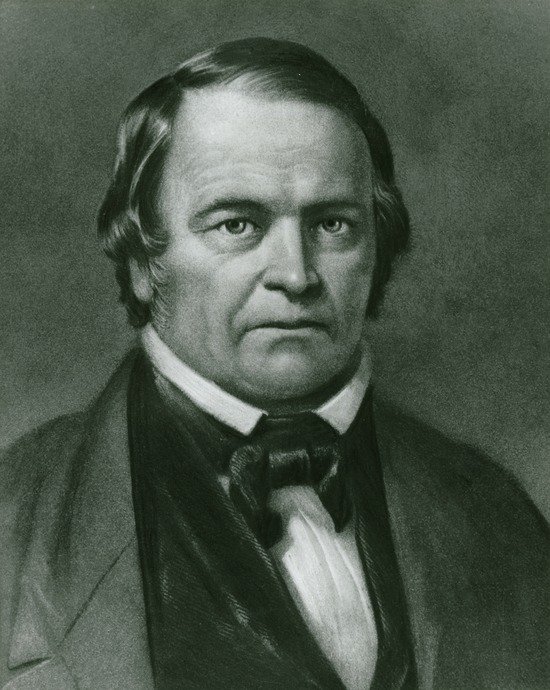
Courtesy of the Ellen G. White Estate, Inc.
In the early 1800s, a man named William Miller decided to study the Bible for himself, from beginning to end.
He discovered all the prophecies in Daniel had been perfectly fulfilled in history up to the fourth kingdom (Rome).
But when he came to the judgment in Daniel 7:9-10, 13-14, he interpreted the coming of the Son of Man to the Ancient of Days to mean the second coming of Jesus back to earth—especially because it mentions Jesus coming with the clouds.
Then in Daniel 8:14, he interpreted the cleansing of the sanctuary to mean the final removal of all sin and sinners from the earth by fire (Revelation 20:9,10,15).
So he concluded that the event that would take place at the end of the 2300 years in 1844 was the Second Coming.
Convicted of the soon return of Christ, he preached this message—and many believed. Those who followed this belief became known as Millerites.
One Millerite by the name Samuel Snow even proposed a specific date: October 22, 1844.
So all the Millerites waited for Jesus to come to earth on that day…but He didn’t.
So great was their disappointment that this event is known in history as the Great Disappointment.
Many gave up on their faith. But one group of people, who would eventually form the Seventh-day Adventist Church, went back to study the Scriptures to see where they’d gone wrong.
After much study and earnest prayer to understand the truth, they discovered that their date was correct, but they were wrong about the event. Instead of Jesus coming to earth, He was moving from the Holy Place to begin His ministry in the Most Holy Place in heaven.
Further study on the judgment in heaven showed that it involved books being opened (Daniel 7:10).
They saw that this judgment was the first among the three judgments that take place in the end times, namely:
1. The pre-advent judgment, which takes place before the second coming of Jesus (Daniel 7:9-10, 13-14).
2. The millennial judgment, which takes place during the Millennium, just after the Second Advent (Revelation 20:4).
3. The executive judgment, which takes place at the end of the Millennium, when sin and Satan and all His followers are destroyed forever (Revelation 20:11-15).
They found that the pre-advent judgment is of an investigative nature.
Let’s find out what that means.
What’s the Investigative Judgment, its purpose, and its outcome?

Photo by Emil Widlund on Unsplash
The pre-advent judgment (also known as the Investigative Judgment) involves looking into the “books” that were opened in Daniel 7:10, for the records of those who profess to be God’s followers.
Just like in the Day of Atonement, when everyone was supposed to confess their sins and accept the work of atonement on their behalf through the sacrificial service, God’s people are to examine their lives, confess any sins they’re struggling with, and make amends to be right with God and receive forgiveness through Christ’s sacrifice if they haven’t yet.
In the Day of Atonement, if one was found holding onto or hiding sin, they were “cut off,” or separated from God’s people (Leviticus 23:29).
In the heavenly judgments, there are life records of all people, what their lives have been like, and what they’ve done (both good and evil).13
Those who confess their sins and have their sins forgiven, all their sinful deeds are removed from the books of record (covered by the atoning blood of Jesus), and their names are written in the book of life. And only those whose names are written in the book of life will have eternal life with God in heaven (Luke 10:20; Philippians 4:3; Daniel 12:1).
Those whose names are not found in it will face the judgment of their works (Revelation 20:12; 21:27). Because this would mean that they were ultimately refusing Christ’s sacrifice and atonement.
And if someone has had their name written in the book of life but they later choose to turn away, their names are removed from the book of life (Revelation 3:5). Because God will never remove our free will that He created us with.
During the pre-advent judgment, God goes through His “books” of record and sees who has accepted the gift of forgiveness and salvation through Christ, and who hasn’t.
So He “investigates” through the books to see the stamp of our character. This is when He determines whether or not we have indeed accepted or rejected Him. He looks at our hearts.
So what’s all this talk about works? Aren’t we judged by faith, not by works (Ephesians 2:8-9)?
Though these verses about the Investigative Judgment mention being judged by “works,” this is talking about a manifestation of whether or not we have already accepted to be saved by the blood of Jesus (Ephesians 2:10; James 1:14-26). Because if we truly believe something, it affects who we are, what we do, etc. It doesn’t make us perfect, but it does affect us. And that’s what God sees.
In other words, the purpose of the Investigative Judgment is to reveal who is an authentic believer in Jesus and His saving grace. Who walks in love and strives toward love?
This investigation is depicted in the parable of the wedding banquet (Matthew 22:1-14).
The wedding guests represent professing believers, the King’s inspection of guests represents the Investigative Judgment of the guests, and the wedding garments represent the robe of Christ’s righteousness that His followers wear to be “judged” as sincere believers.
Apart from deciding who will be saved and who won’t, the judgment also serves to vindicate God’s justice in saving those who believe in Jesus.
It may seem strange to think of an all-powerful deity, the Creator of all things, to be looking at physical books or sitting in a courtroom. But the Bible authors knew that this would be an acceptable and relatable analogy to understand God’s processes of judgment, salvation, atonement, redemption, etc.
God knew that these roles and ideals are how we typically understand law, morality, and justice. So whether there’s an actual book or not, what we can have faith in is that Jesus knows everything. Everything is recorded and taken into account—He won’t “miss” anything. This is how we’re shown that He is fair and loving, just and merciful—and that He has everything under control. All will be made right.
And that’s why the Investigative Judgment plays an important part in prophecy about the End Times and humanity’s salvation. It shows us that our eternal destiny isn’t arbitrarily decided. God looks at who we really are and what we really, truly want. Those that experience the second death will be those that chose against living with Jesus for eternity (Revelation 2:11; 20:6; 22:11).
And it’s the same outcome of the Investigative Judgment that will be confirmed by God’s people during the Millennium at the millennial judgment, and also at the final executive judgment that will bring an end to all sin (Revelation 20:4,11-15).
Some of those who contributed to the development of the understanding of this doctrine include leaders in the Adventist Church, such as Elon Everts, James White, Uriah Smith, J. N. Andrews, and Ellen G. White.14
Writing of the Investigative Judgment, Ellen White says:
“As the books of record are opened in the judgment, the lives of all who have believed on Jesus come in review before God. Beginning with those who first lived upon the earth, our Advocate presents the cases of each successive generation, and closes with the living. Every name is mentioned, every case closely investigated.”15
Later, when Adventists organized into a denomination and decided to put together their statements of beliefs about the Bible, they included their understanding of the Investigative Judgment. It’s recorded as part of belief 24: Christ’s ministry in the heavenly sanctuary.16
And at the heart of the work in the heavenly sanctuary, and at the heart of God’s judgment, is God’s love for us. It’s about freeing humanity from sin and evil and offering us redemption, should we so choose it.
The 2300-day prophecy shows that Jesus is working for us
The 2300-day prophecy walks us through God’s involvement in human history, as well as His great plan for our salvation.
It shows us how Jesus is ministering for us as our merciful and compassionate high priest.
And as our cases are being examined in the heavenly sanctuary, He is there, advocating for us against Satan’s accusations.
Though eternity is literally at stake for us in the ongoing judgment in heaven, we can take comfort in knowing that in the end, judgment will be given in favor of God’s people, and we’ll inherit the kingdom of God (Daniel 7:22).
Jesus has already made a way for us to be cleansed from our sins through His death on the cross. All we need to do is accept His salvation.
And even if we fall into sin, we can have the peace that if we confess our sins, He’ll forgive us. And if Satan keeps trying to accuse and condemn us before God, we have “an advocate with the father, Jesus Christ the righteous” (1 John 1:9, NKJV; 1 John 2:1-2, NKJV).
From all this, we see how intriguing Bible prophecy can be. How just a few words can pack in a world of significance—telling us of God’s grand plans for all of history, and how we each fit into that plan.
We also see how, through diligent study of Scripture, we can understand what God meant to communicate to us through His prophetic word, no matter how complex it may appear at first.
God wants to teach us more in His Word, and has given us the Holy Spirit to help us understand the truth (John 16:13).
To learn more about Bible prophecy,
- Jeremiah 29:10; 2 Chronicles 36:20-23; Daniel 8:1; 5:30; Daniel 9:1-2. [↵]
- Nichol, Francis D., ed.,The Seventh-Day Adventist Bible Commentary, vol. 4, pp. 771-777 [↵]
- The book, Ancient Israel: From Abraham to the Roman Destruction of the Temple [Biblical Archeology Society, 2010]. Or the famous work by Jewish British historian Simon Sebag Montefiore called Jerusalem: A Biography [Alfred Knopf, 2011] [↵]
- Nichol, Francis D., ed., The Seventh-Day Adventist Bible Commentary, vol. 4, pp. 819-838 [↵]
- Ibid., pp. 800-801, 839-847 [↵]
- Strong, James, Strong’s Exhaustive Concordance of the Bible,# H7620 (week), pp. 1499, 147 [↵]
- Strong, James, Strong’s Exhaustive Concordance of the Bible, #H2852 (determined), pp. 347, 58 [↵]
- Nichol, Francis D., ed., The Seventh-Day Adventist Bible Commentary, vol. 4, pp. 853. [↵]
- https://www.ministrymagazine.org/archive/1939/09/three-schools-of-prophetic-interpretation [↵]
- Adventist Theological Seminary at Andrews University, “In defense of the year-day principle”, https://digitalcommons.andrews.edu/cgi/viewcontent.cgi?article=1098&context=jats [↵]
- Adventist Theological Seminary at Andrews University, “The Meaning of Nisdaq in Daniel 8:14”, https://digitalcommons.andrews.edu/cgi/viewcontent.cgi?article=1395&context=jats [↵]
- Acts 7:56; Mark 2:10-11; 8:31; 14:62; Matthew 9:6; 26:64; Luke 5:24; 9:22; 22:69; Hebrews 2:6-9. [↵]
- Psalm 130:3; 2 Corinthians 5:10; Ecclesiastes 12:13-14; Ephesians 6:8; Colossians 3:25; 1 Timothy 6:19 [↵]
- https://atoday.org/the-real-history-of-the-investigative-judgment-doctrine/ [↵]
- White, Ellen G., The Great Controversy, p. 483. [↵]
- https://szu.adventist.org/wp-content/uploads/2016/04/28_Beliefs.pdf [↵]
Related Articles
More Answers
Major Fulfilled Bible Prophecies You Should Know About
Prophets seem like something from novels or movies.
What Is the Statue in Nebuchadnezzar’s Dream?
Ever had a dream you couldn’t remember? You know it was disturbing, but the details escape you. Ugh, the frustration!
What Is the 70-Week Prophecy in Daniel 9
Could a prophecy accurately predict an event over 500 years before it was supposed to happen?
Didn’t find your answer? Ask us!
We understand your concern of having questions but not knowing who to ask—we’ve felt it ourselves. When you’re ready to learn more about Adventists, send us a question! We know a thing or two about Adventists.

